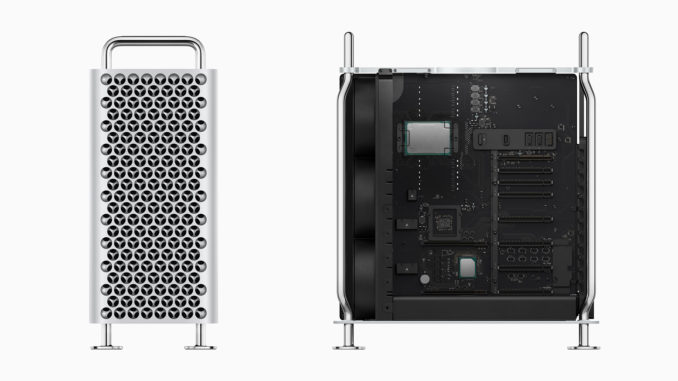
The new Mac Pro from Apple is actually a normal computer again. However, the SSDs are not connected with M.2, but with a proprietary port.
The new Mac Pro is a normal computer all over again
Apple introduced the new Mac Pro at this year’s WWDC. After the Mac Pro from 2013 in the form of a trash can, Apple is almost not breaking new ground with its shape and construction. The cooling system is server-inspired, the processor is socketed and not soldered, and even the expansion cards are housed in normal PCIe 3.0 slots. The only exception are the graphics cards that come on their own board called MPX, which has another specially developed PCIe slot. According to the current information, an ordinary PCIe graphics card can simply be installed in the Mac Pro. Even the electricity connections for it are available. The main memory is also contained in standard DIMM slots.
In general Apple is finally going back to a relatively normal way without much proprietary hardware. The new Mac Pro, nicknamed cheese grater, even looks like an ordinary computer. The price, which starts at $6,000 and could crack the $50,000 mark in the top configuration, can of course be argued about, but it is still to be welcomed that Apple no longer prevents or hinders independent upgrades. The only exception could be the SSD memory.
No M.2 slot for SSDs, but proprietary solution
Especially when it comes to flash memory, Apple is repeatedly criticized for very expensive upgrades. This could be especially true for the Mac Pro, which is equipped with 256 gigabytes of NVMe capacity by default. Originally, it seemed as if Apple would use simple M.2 SSDs, for which two slots would be available. Apparently it’s not an ordinary M.2 slot, but a proprietary port that Apple uses. Internal Apple sources have now confirmed this to AppleInsider. According to this, flash memory without a memory controller is used, as with the iMac Pro. This controller is located in the T2 security chip, which also encrypts the memory.
Thus, high prices for the up to 4 terabytes of NVMe memory at Apple will be due again. However, the usual PCIe slots of the Mac Pro could also be used to easily install PCIe expansion cards with memory. Also two built-in SATA ports probably allow the expansion with cheaper SSDs. It remains to be seen whether Apple has blocked these options by the T2 chip.

Be the first to comment